Why MS Patients Are Turning to Cold Plunges for Relief and Resilience
🧊 Introduction: A Surprising Tool in the MS Toolkit
Multiple sclerosis is unpredictable. One day you’re functional, the next you’re exhausted, stiff, overwhelmed, or foggy. While medication can help manage disease progression, it often leaves patients searching for non-pharmaceutical strategies to cope with daily symptoms. That’s where cold plunges come in.
These short, controlled immersions in cold water are gaining popularity as a form of nervous system training, inflammation control, and stress relief. For people living with MS—where the nervous system is under constant attack—cold plunges may offer something unexpected: a way to reset and build resilience.
Want a cold plunge? Click here.
❄️ What Is a Cold Plunge?
A cold plunge involves immersing the body in cold water—typically between 10–15°C (50–59°F)—for a short period of time (30 seconds to 5 minutes). Common forms include:
- Cold showers
- Bathtub plunges at home
- Commercial cold plunge tubs
- Outdoor dips in lakes or rivers
Unlike cryotherapy (brief exposure to extreme cold air), cold plunges fully engage the skin and nervous system, leading to a host of physiological effects.
🌡️ MS and the Problem of Heat
Before understanding why cold helps, it’s crucial to understand how heat affects MS.
Many people with MS experience a worsening of symptoms when they overheat—a phenomenon known as Uhthoff’s phenomenon. This temporary flare can be triggered by:
- Hot weather
- Exercise
- Hot showers
- Stress or fever
Heat slows or blocks nerve signals in already damaged pathways, causing:
- Muscle weakness
- Visual disturbances
- Brain fog
- Coordination issues
- Crushing fatigue
Cold plunges offer a direct way to reverse this, even temporarily—by lowering core body temperature and improving nerve conduction.
🧠 How Cold Plunges Help with MS Symptoms
Let’s dive deeper into the science-backed reasons why people with MS are turning to cold therapy.
1. Restores Nervous System Balance

MS affects the central nervous system—but also dysregulates the autonomic nervous system, which controls your body’s stress response. Cold plunges activate the vagus nerve, helping shift from a chronic fight-or-flight state to a rest-and-repair state.
Potential Benefits:
- Reduced anxiety and panic
- Improved digestion and heart rate variability
- Better sleep
- Quicker recovery from stress or symptom spikes
This matters because emotional stress can trigger flares, and cold exposure may help break that cycle.
2. Reduces Inflammation
MS is fundamentally an inflammatory disease. Emerging research suggests that cold exposure may lower inflammatory cytokines and increase anti-inflammatory markers.
Cold plunges may reduce:
- TNF-alpha, linked to demyelination
- IL-6, associated with fatigue and depression
- C-reactive protein (CRP), a general inflammation marker
While more MS-specific research is needed, this downshift in inflammation could ease flare recovery and help prevent symptom escalation.
3. Boosts Mood and Mental Clarity
One of the immediate effects of cold water is a surge of norepinephrine and dopamine—neurochemicals that increase focus and feelings of well-being. This can:
- Improve mood
- Reduce brain fog
- Support motivation
- Act as a natural antidepressant over time
For MS patients facing depression, apathy, or cognitive dysfunction, this neurochemical boost can provide a much-needed mental refresh.
4. Alleviates Spasticity and Muscle Fatigue
Many with MS experience muscle spasticity, tightness, or cramps. Cold plunges may:
- Decrease nerve overactivity
- Relax muscle tone
- Improve circulation post-exposure
- Reduce lactic acid buildup
Some patients report better movement, less stiffness, and easier transitions into physical therapy or stretching after a plunge.
5. Builds Resilience
Cold exposure is a form of hormetic stress—a mild challenge that strengthens your body’s ability to adapt. For those with MS, this kind of controlled stress can help train the nervous system to become more flexible and responsive.
Over time, cold plunges may help improve:
- Stress tolerance
- Sleep quality
- Energy levels
- Sense of agency and empowerment
🔄 From Flare-Up to Reset: Why It Works

MS flares often leave you feeling hijacked by your own body. Cold plunges offer a fast, embodied way to reclaim calm and reset your system. Some people with MS describe it as:
“Hitting the reset button on my body and brain.”
When symptoms spike, a plunge (or even a 60-second cold shower) may help:
- Reduce temperature-induced symptoms
- Bring down nervous system overload
- Shift mood from despair to clarity
- Signal safety to the body and mind
⚖️ Is It Safe for Everyone?
Not always. While many MS patients benefit, cold exposure may be risky if you have:
- Heart conditions or arrhythmias
- Raynaud’s disease or poor circulation
- Severe sensory loss (risk of injury or burns)
- Autonomic nervous system dysfunction (blood pressure regulation issues)
Also, avoid plunging during a major relapse or if you’re severely fatigued or unwell.
Always consult your neurologist before starting cold therapy, especially if you’re on medications or have cardiovascular risks.
🛁 How to Start Cold Plunges Safely at Home
You don’t need a $5,000 cold tub to get started. Here’s a practical step-by-step guide.
✅ Step 1: Start with Cold Showers
Finish your warm shower with 30 seconds of cold
Gradually increase to 1–3 minutes
Focus on breathing: inhale slowly, exhale longer
✅ Step 2: DIY Cold Plunge Setup
Use a bathtub with cold water + ice trays
Or try an outdoor barrel, trough, or inflatable plunge
Aim for 10–15°C (50–59°F) using a water thermometer
Keep sessions under 5 minutes, especially at first
✅ Step 3: Build a Routine
Try 2–3 sessions per week
Pair with stretching, breathwork, or journaling
Track symptoms in a journal to assess impact over time
✅ Step 4: Warm Up Slowly
Don’t jump into a hot shower afterward
Instead, bundle up, sip tea, and move gently
🧘 Layering Recovery: What to Combine Cold Plunges With
Cold plunges are most effective when paired with other MS-friendly practices, such as:
| Recovery Practice | Why It Helps |
|---|---|
| Breathwork | Reinforces nervous system calm |
| Gentle yoga/stretching | Reduces stiffness and supports movement |
| Anti-inflammatory diet | Enhances immune balance |
| Adaptogens (e.g. ashwagandha) | Supports stress resilience |
| Meditation or grounding | Builds emotional steadiness |
| Sleep hygiene | Supports repair and immune modulation |
These practices don’t replace your medications—they complement them by supporting whole-body resilience.
💬 Real MS Voices: Testimonials on Cold Plunge Therapy
“My fatigue was so overwhelming, I could barely start my day. Now I do a 2-minute plunge every morning. It’s like flipping a switch.”
— Eric, 35, diagnosed 2 years ago
“I use a cold plunge after physical therapy. It helps calm my muscles and keeps me from crashing later.”
— Sandra, 44, SPMS
“After a rough flare, I was anxious and foggy. Cold water helped me feel like myself again—mentally and physically.”
— Maya, 29, RRMS
“It’s the one thing I’ve tried that actually gives me control over how I feel, even just for a few minutes.”
— Luke, 51, MS for 12 years
🔍 Why MS Patients Are Leading the Cold Revolution
Cold plunges are not just a trend—they’re a powerful way to reclaim control over a condition that often feels uncontrollable. For MS warriors, the appeal lies in the simplicity:
- It’s natural and non-toxic
- It supports both body and mind
- It’s adaptable to any budget
- It provides real-time relief
- It builds inner strength and resilience
As more people living with MS seek ways to live better, not just longer, tools like cold plunge therapy are becoming pillars of a new model of empowered self-care.
Want a cold plunge? Click here.
📚 References
Davis, S. L., et al. (2010). Thermoregulation in multiple sclerosis. Journal of Applied Physiology, 109(5), 1531–1537.
Kox, M., et al. (2014). Voluntary activation of the sympathetic nervous system and attenuation of the innate immune response in humans. PNAS, 111(20), 7379–7384.
Huttunen, P., et al. (2004). Health effects of cold exposure: a scoping review. International Journal of Circumpolar Health, 63(2), 243–245.
van der Meijden, W. P., et al. (2022). Cold exposure and neuromodulation: Exploring the vagus nerve’s role in inflammation and mental health. Frontiers in Neuroscience, 16, 889330.
Yamane, M., et al. (2006). Influence of prior hyperthermia on exercise-induced heat shock protein 72 response in human skeletal muscle. American Journal of Physiology, 290(6).
Tracey, K. J. (2007). Physiology and immunology of the cholinergic antiinflammatory pathway. Journal of Clinical Investigation, 117(2), 289–296.
Related Posts
-

Learning to Feel Safe in Your Body Again
If your body no longer feels like a safe place—due to trauma, chronic illness, or anxiety—you’re not alone. This guide offers gentle, body-based strategies to help you reconnect with yourself, regulate your nervous system, and rebuild trust in your physical experience.
-

When You Feel Emotionally Unlovable: Challenging the Lie
Feeling unlovable because of your emotions, illness, or sensitivity? You’re not broken—you’re healing. Learn how to challenge the lie of emotional unworthiness and rebuild self-trust, one compassionate step at a time.
-
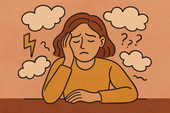
Brain Fog and Fatigue: How to Stop Blaming Yourself
Struggling with brain fog or chronic fatigue? You’re not lazy or failing. Learn how to stop blaming yourself for symptoms caused by MS or chronic illness, and start embracing a more compassionate path to healing and self-understanding.
-

Creating an Emotional Support Team You Actually Trust
Tired of feeling unsupported or misunderstood? Learn how to build an emotional support team you actually trust—with people who see you, hold space for you, and respect your boundaries, especially when living with MS or chronic illness.
-

MS, Vulnerability, and the Fear of Being Seen
Living with MS can make vulnerability feel unsafe. Learn why so many people with MS hide their struggles—and how to gently move toward authenticity, self-acceptance, and deeper connection without shame.
-
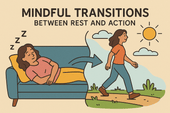
Mindful Transitions Between Rest and Action
Struggling to shift between rest and activity without guilt or overwhelm? This guide offers gentle, mindful strategies to make transitions feel more natural, intentional, and supportive of your nervous system.
-

The Pain of Being Misunderstood—And How to Cope
Feeling the sting of being misunderstood? Learn why it hurts so deeply and discover practical, healing strategies to protect your truth, communicate clearly, and rebuild emotional safety when others just don’t get it.
-

Letting Go of Productivity Guilt When You Need to Rest
Struggling with guilt every time you try to rest? Learn how to release productivity shame, understand why rest matters, and embrace a more compassionate rhythm for healing and recovery—without feeling lazy.
-

Rebuilding Energy Reserves Without Shame
-

What to Do If You Feel Emotionally Invalidated by Doctors
Feeling emotionally invalidated by your doctor can be deeply distressing. Learn how to recognize medical gaslighting, validate your own experience, and advocate for better care when you’re not being heard.
-

How to Rest Without Feeling Lazy
Rest isn’t laziness—it’s a necessary act of self-respect. Learn how to shift your mindset, let go of guilt, and embrace rest as a vital part of mental and physical well-being.
-

Redefining Energy Management as Emotional Self-Care
Energy isn’t just physical—it’s emotional. Learn how redefining energy management as emotional self-care can help you protect your peace, support your nervous system, and live more in tune with your true needs.
-
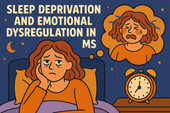
Sleep Deprivation and Emotional Dysregulation in MS
-

How to Cope When Friends Disappear After Diagnosis
Losing friends after a diagnosis can feel like another kind of grief. Discover why some friends disappear—and how to cope with the emotional fallout while building more supportive relationships.
-

How to Talk to Your Kids About MS Without Overwhelming Them
Struggling with how to explain MS to your kids? Learn how to talk to children of all ages about multiple sclerosis with honesty, clarity, and emotional safety—without overwhelming them.
-

MS and the Fear of Emotional Abandonment
The fear of emotional abandonment is common for people with MS. This article explores why it happens, how it impacts your relationships, and how to create emotional safety and healing.
-

Forgiveness, Closure, and Letting Go of the Past with MS
Living with MS often brings emotional wounds from the past. Learn how forgiveness, closure, and letting go can help you heal emotionally—and reclaim peace in the present.
-
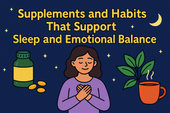
Supplements and Habits That Support Sleep and Emotional Balance
Struggling with poor sleep and emotional ups and downs? Discover calming supplements and daily habits that support deep rest and mental well-being—backed by science and easy to implement.
-

When Insomnia Feels Like Your MS Brain Won’t Turn Off
Struggling to sleep with MS? When your brain won’t shut off at night, insomnia feels relentless. Learn what causes it—and discover science-backed strategies to calm your mind and finally rest.
-

The Emotional Toll of Waking Up Tired Every Day: Why It Hurts More Than You Think
Waking up tired every day takes a deep emotional toll—from mood swings to lost motivation and self-doubt. Learn why chronic fatigue hurts more than you think and how to gently reclaim your mornings.
-
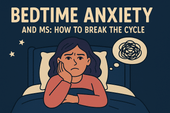
Bedtime Anxiety and MS: How to Break the Cycle
Bedtime anxiety is a common struggle for people with MS—and it’s more than just racing thoughts. Learn how MS-related stress, nervous system dysregulation, and fear of symptoms can create a cycle of sleeplessness, and discover practical, calming strategies to finally reclaim restful nights.
-
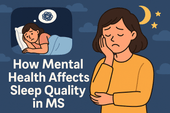
How Mental Health Affects Sleep Quality in MS: Breaking the Cycle of Fatigue and Emotional Distress
Struggling to sleep when you have MS? Discover how anxiety, depression, and neurological changes impact your rest—and what you can do to reclaim it. From CBT-I and calming supplements to lifestyle tips that support both mental health and sleep, this guide offers practical strategies for better nights.
-

Learning to Love Your Life (Even When It’s Not What You Expected)
Your life may not look how you imagined—but it’s still worth loving. Learn how to find peace, purpose, and joy in the unexpected.
-
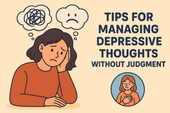
Tips for Managing Depressive Thoughts Without Judgment
Learn how to meet depressive thoughts with compassion, not shame. These gentle, research-backed tools help you manage low moods without self-judgment.
-

Rewiring Hope: How to Slowly Come Back to Life
Feeling emotionally numb or disconnected? Learn how to gently rebuild hope, one small sensory step and spark of life at a time.
-

Depression and Suicidality in MS: A Conversation That Needs to Happen
Depression and suicidality in MS are real—and urgent. Learn why we must talk about it, how to spot warning signs, and where to find help and hope.
-

Finding Meaning When Life Feels Empty
Feeling disconnected or numb? Discover gentle ways to find meaning again—even in emptiness—through daily rituals, reflection, and purpose.
-

The Power of Daily Structure in Preventing Mental Health Spirals
Daily structure can prevent mental health spirals by creating safety, routine, and self-trust—especially for those with MS, depression, or anxiety.
-

Healing from Emotional Flatness with Sensory Rituals
Feeling emotionally numb or disconnected? Discover how sensory rituals can gently restore pleasure, presence, and emotional resilience.
-

The Role of Light Therapy for Seasonal Depression and MS
Can light therapy ease seasonal depression in people with MS? Discover the science, benefits, and how to use it safely for better mood and energy.
-

Medication vs Therapy: Treating MS-Related Depression Effectively
Explore whether therapy, medication, or both are best for treating MS-related depression. Understand what works, when—and why combination care is often ideal.
-

How to Support a Partner with MS and Depression
Learn how to support a partner living with MS and depression—practical tips, emotional tools, and ways to protect your own mental health too.
-

The Emotional Cost of Losing Your Old Life
Losing your old life to MS isn’t just about physical symptoms—it’s about grieving the identity, dreams, and freedom you once had. This article explores the emotional toll of invisible grief and how to begin healing without denying the pain.
-
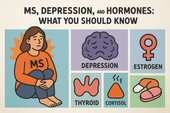
MS, Depression, and Hormones: What You Should Know
MS-related depression isn’t always just emotional—it can be hormonal. Discover how thyroid, sex, and stress hormones influence mood in MS, why women may feel worse during PMS or menopause, and what signs to look for when hormones may be driving emotional instability.
-

MS and Anhedonia: Reclaiming Pleasure One Step at a Time
Anhedonia—feeling emotionally flat or disconnected—is a common but misunderstood symptom of MS depression. This article explores how neuroinflammation, dopamine disruption, and fatigue can dull your sense of joy—and how small, gentle steps can help you begin to feel again.
-
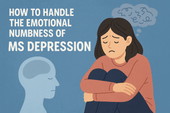
How to Handle the Emotional Numbness of MS Depression
Emotional numbness in MS depression doesn’t always look like sadness—it can feel like nothing at all. Learn why this disconnection happens, how it's tied to neuroinflammation and nervous system overload, and discover science-backed strategies to gently reconnect with your emotions.
-
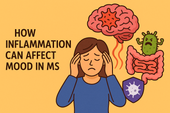
How Inflammation Can Affect Mood in MS
Mood swings and emotional numbness in MS aren’t just psychological—they can be driven by immune system inflammation. This article explores how inflammatory cytokines affect the brain, why mood changes are often biological, and what you can do to calm your nervous system from the inside out.
-
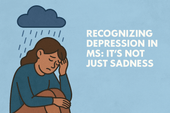
Recognizing Depression in MS: It's Not Just Sadness
Depression in multiple sclerosis (MS) is more than just sadness—it can be a neurological symptom, a side effect of inflammation, or a silent weight that masks itself as fatigue or emotional numbness. This article helps you recognize the hidden signs of MS-related depression, understand the science behind it, and explore real treatment options that support both mental and physical health.
-

Is Cryotherapy Safe for MS? Pros, Cons, and How It Compares to Cold Plunges
Cryotherapy promises quick recovery, inflammation reduction, and mood support—but is it safe for people with MS? This article breaks down the science, risks, and real-life benefits of cryotherapy for multiple sclerosis. You’ll also learn how it compares to cold plunges and which option may be better for calming flares and regulating your nervous system.
-

Can Cold Plunges Help Reduce Inflammatory Flares in MS?
Flares in multiple sclerosis (MS) are often driven by inflammation—but what if cold water could help turn down the heat? This in-depth article explores how cold plunges may help reduce flare frequency and intensity in MS by calming the immune system, lowering pro-inflammatory cytokines, and regulating the nervous system. Learn how to safely use cold exposure as part of your MS recovery routine.
-
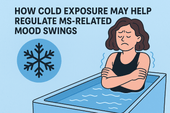
How Cold Exposure May Help Regulate MS-Related Mood Swings
Mood swings are a common but overlooked challenge in multiple sclerosis (MS). This article explores how cold exposure—like cold plunges and showers—may help regulate emotional ups and downs by calming the nervous system, reducing inflammation, and boosting mood-enhancing chemicals. Learn how to use this natural tool safely to support your mental and emotional resilience with MS.
-
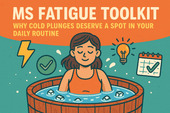
MS Fatigue Toolkit: Why Cold Plunges Deserve a Spot in Your Daily Routine
Fatigue is one of the most debilitating symptoms of multiple sclerosis (MS)—often invisible, misunderstood, and overwhelming. While no single tool can eliminate it, building a personalized fatigue management toolkit can make life more manageable. One surprising contender? Cold plunges. In this article, we explore why cold water immersion might be the refresh button your nervous system needs—and how to safely make it part of your MS fatigue routine.
-
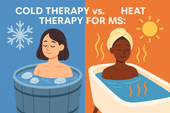
Cold Therapy vs. Heat Therapy for MS: Which One Helps More?
Managing multiple sclerosis (MS) often means navigating symptoms like fatigue, spasticity, pain, and nerve dysfunction. But when it comes to using temperature-based therapies, there’s a question many patients face: Should I be using cold or heat? In this in-depth guide, we explore the benefits, risks, and best use cases of cold therapy vs. heat therapy for MS.
-
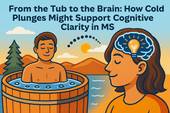
From the Tub to the Brain: How Cold Plunges Might Support Cognitive Clarity in MS
Cognitive fog is one of the most frustrating symptoms of multiple sclerosis (MS). But could cold plunges—those bracing dips into icy water—offer a surprising path to mental clarity? This article explores the emerging science behind cold exposure, brain function, and how a cold tub might help people with MS sharpen focus, lift brain fog, and reset their nervous system.
-
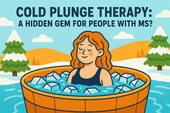
Cold Plunge Therapy: A Hidden Gem for People with MS?
Cold plunge therapy—once the domain of elite athletes and biohackers—is gaining attention among people with multiple sclerosis (MS). Could it help reduce inflammation, calm the nervous system, and ease MS symptoms like fatigue and spasticity? In this article, we dive deep into the science, benefits, safety, and practical application of cold plunges for MS recovery and symptom relief.
-
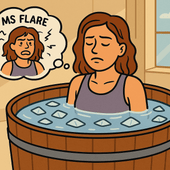
Finding Relief in the Midst of a Flare
MS flares can leave you feeling overwhelmed, exhausted, and mentally foggy. Cold water therapy is emerging as a promising tool to help reset the body and mind after a flare. This article explores how cold exposure supports recovery, calms the nervous system, and can be safely added to your daily routine.
-
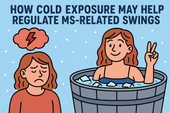
How Cold Exposure May Help Regulate MS-Related Mood Swings
Mood swings in multiple sclerosis (MS) can feel like emotional whiplash—one moment calm, the next overwhelmed, angry, or hopeless. While medications and therapy help, many people with MS are exploring natural strategies to support emotional balance. One surprising tool gaining attention? Cold exposure. In this article, we explore how cold plunges and other forms of cold therapy may regulate the nervous system, stabilize mood, and offer emotional relief for people with MS.
-
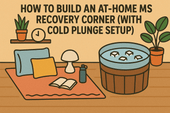
How to Build an At-Home MS Recovery Corner (with Cold Plunge Setup)
Create your personal MS recovery oasis at home—complete with a cold plunge setup. Learn how to design a space that supports healing, reduces inflammation, and helps you manage symptoms naturally.
-
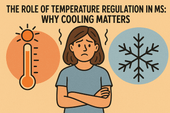
The Role of Temperature Regulation in MS: Why Cooling Matters

















































